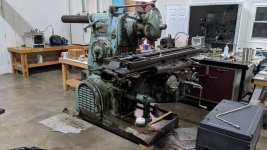This was my axelson 16" I sold this one and the guy took it on and has really , really done a nice job... Needle scaler is the way to go! Probably took 8 to 10 hours to get this down to bare metal... Wear a mask, you do know how to by now...

After scaling it he wiped it down and he started applying a Sherwin Williams DTM paint that is fairly new. DTM is direct to metal and needs no primer. It dries hard and is not affected by oils and coolant. Most of the lathe is hand painted with some parts sprayed. It all depended on where it was and how hard it would be to mask off the machine.
Biggest problem was getting it thinned out to flow , said it was a really "sticky paint" After some experimenting he got it just right and the results speak for themselves...
And I just love the color

Getting the paint on was much harder than getting it off with the scaler
 Pictures are in this thread...
Pictures are in this thread...





